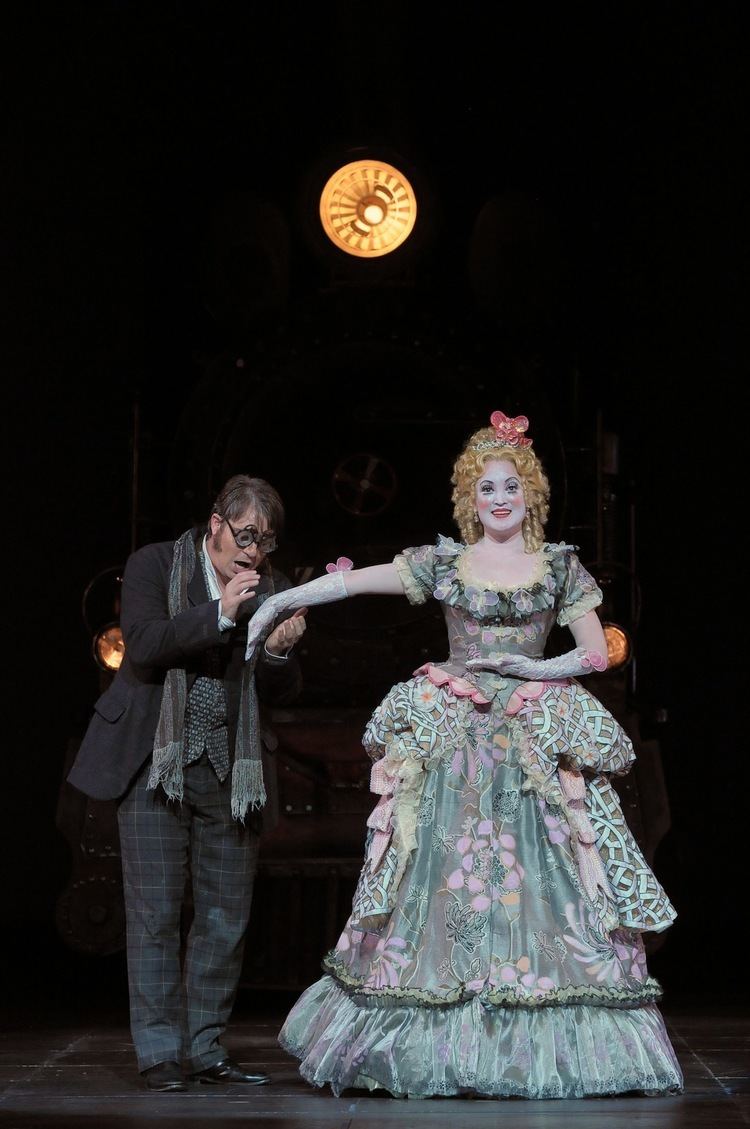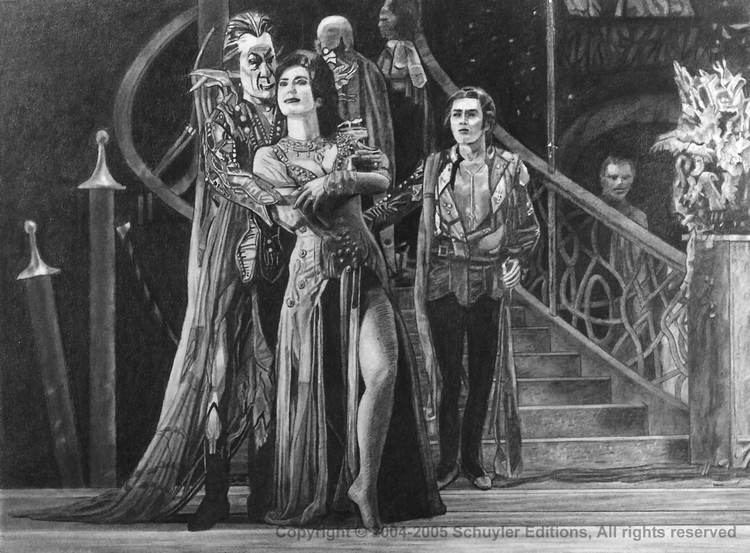Native title Les contes d'Hoffmann Language French | ||
 | ||
Based on three short storiesby E. T. A. Hoffmann Arias Les oiseaux dans la charmille Characters Nicklausse, Pitichinaccio, Dapertutto , Spalanzani Similar Don Giovanni, The Marriage of Figaro, Così fan tutte, Rigoletto, La traviata | ||
Offenbach barcarolle from the tales of hoffmann
The Tales of Hoffmann (French: Les contes d'Hoffmann) is an opéra fantastique by Jacques Offenbach. The French libretto was written by Jules Barbier, based on three short stories by E. T. A. Hoffmann, who is the protagonist of the story. It was Offenbach's final work, as he died a year before the premiere.
Contents
- Offenbach barcarolle from the tales of hoffmann
- Performance history
- Prologue
- Act 1 Olympia
- Act 2 Antonia
- Act 3 Giulietta
- Epilogue
- Musical numbers
- Editions
- Recordings
- Film
- References

Performance history

The opera was first performed in a public venue, at the Opéra-Comique on 10 February 1881, without the third (Venice) act. It had been presented in an abridged form at Offenbach's house, 8 Boulevard des Capucines, on 18 May 1879, with Madame Franck-Duvernoy in the soprano roles, Auguez as Hoffmann (baritone) and Émile-Alexandre Taskin in the four villain roles, with Edmond Duvernoy at the piano and a chorus directed by Albert Vizentini. Besides Léon Carvalho, director of the Opéra-Comique, the director of the Ringtheater in Vienna, Franz von Jauner, was also present. Both men requested the rights, but Offenbach granted them to Carvalho.

A four-act version with recitatives was staged at the Ringtheater on 7 December 1881, conducted by Joseph Hellmesberger Jr., although a gas explosion and fire occurred at the theatre after the second performance.

The opera reached its hundredth performance at the Salle Favart on the 15 December 1881. The fire at the Opéra-Comique in 1887 destroyed the orchestral parts, and it was not seen again in Paris until 1893, at the Salle de la Renaissance du Théâtre-Lyrique, when it received 20 performances. A new production by Albert Carré (including the Venice act) was mounted at the Opéra-Comique in 1911, with Léon Beyle in the title role and Albert Wolff conducting. This production remained in the repertoire until World War II, receiving 700 performances. Following a recording by Opéra-Comique forces in March 1948, Louis Musy created the first post-war production in Paris, conducted by André Cluytens. The Paris Opera first staged the work in October 1974, directed by Patrice Chéreau with Nicolai Gedda in the title role.

Outside France, the piece was mounted in Geneva, Budapest, Hamburg, New York, and Mexico in 1882, Vienna (Theater an der Wien), Prague, and Antwerp in 1883, and Lvov and Berlin in 1884. Later local premieres included Buenos Aires in 1894, St Petersburg in 1899, Barcelona in 1905, and London in 1910.
Prologue
A tavern in Nuremberg. The Muse appears and reveals to the audience that her purpose is to draw Hoffmann's attention to herself, and to make him abjure all other loves, so he can be devoted fully to her: poetry. She takes the appearance of Hoffmann's closest friend, Nicklausse. The prima donna Stella, currently performing Mozart's Don Giovanni, sends a letter to Hoffmann, requesting a meeting in her dressing room after the performance. The letter and the key to the room are intercepted by Councillor Lindorf ("Dans les rôles d'amoureux langoureux" – In the languid lovers' roles), who is the first of the opera's incarnations of evil, Hoffmann's nemesis. Lindorf intends to replace Hoffmann at the rendezvous. In the tavern students wait for Hoffmann. He finally arrives and entertains them with the legend of Zaches the dwarf ("Il était une fois à la cour d'Eisenach" – Once upon a time at the court of Eisenach). Lindorf coaxes Hoffmann into telling the audience about his life's three great loves.
Act 1 (Olympia)
This act is based on a portion of "Der Sandmann" (The Sandman).
Hoffmann's first love is Olympia, an automaton created by the scientist Spalanzani. Hoffmann falls in love with her, not knowing that Olympia is a mechanical doll ("Allons! Courage et confiance...Ah! vivre deux!" – Come on! Courage and confidence ... Ah! to live!). To warn Hoffmann, Nicklausse, who knows the truth about Olympia, sings a story of a mechanical doll who looked like a human, but Hoffmann ignores him ("Une poupée aux yeux d'émail" – A doll with enamel eyes). Coppélius, Olympia's co-creator and this act's incarnation of Nemesis, sells Hoffmann magic glasses that make Olympia appear as a real woman ("J'ai des yeux" – I have eyes).
Olympia sings one of the opera's most famous arias, "Les oiseaux dans la charmille" (The birds in the arbor, nicknamed "The Doll Song"), during which she periodically runs down and needs to be wound up before she can continue. Hoffmann is tricked into believing that his affections are returned, to the bemusement of Nicklausse, who subtly tries to warn his friend ("Voyez-la sous son éventail" – See her under her fan). While dancing with Olympia, Hoffmann falls on the ground and his glasses break. At the same time, Coppélius appears and tears Olympia apart to retaliate against Spalanzani, who tricked him out of his fees. With the crowd laughing at him, Hoffmann realizes that he was in love with an automaton.
Act 2 (Antonia)
This act is based on "Rath Krespel".
After a long search, Hoffmann finds the house where Crespel and his daughter Antonia are hiding. Hoffmann and Antonia loved each other, but were separated when Crespel decided to hide his daughter from Hoffmann. Antonia has inherited her mother's talent for singing, but her father forbids her to sing because of the mysterious illness from which she suffers. Antonia wishes that her lover would return to her ("Elle a fui, la tourterelle" – "She fled, the dove"). Her father also forbids her to see Hoffmann, who encourages Antonia in her musical career, and therefore endangers her without knowing it. Crespel tells Frantz, his servant, to stay with his daughter, and when Crespel leaves, Frantz sings "Jour et nuit je me mets en quatre" – "Day and night I quarter my mind."
When Crespel leaves his house, Hoffmann takes advantage of the occasion to sneak in, and the lovers are reunited (love duet: "C'est une chanson d'amour" – "It's a love song"). When Crespel returns, he receives a visit from Dr Miracle, the act's Nemesis, who forces Crespel to let him heal Antonia. Still in the house, Hoffmann listens to the conversation and learns that Antonia may die if she sings too much. He returns to her room and makes her promise to give up her artistic dreams. Antonia reluctantly accepts her lover's will. Once she is alone, Dr Miracle enters Antonia's room and tries to persuade her to sing and follow her mother's path to glory, stating that Hoffmann is sacrificing her to his brutishness and loves her only for her beauty. With mystic powers, he raises a vision of Antonia's dead mother and induces Antonia to sing, causing her death. Crespel arrives just in time to witness his daughter's last breath. Hoffmann enters the room and Crespel wants to kill him, thinking that he is responsible for his daughter's death. Nicklausse saves his friend from the old man's vengeance.
Act 3 (Giulietta)
This act is very loosely based on Die Abenteuer der Silvester-Nacht (A New Year's Eve Adventure).
Venice. The act opens with the barcarolle "Belle nuit, ô nuit d'amour" – "Beautiful night, oh night of love". Hoffmann falls in love with the courtesan Giulietta and thinks she returns his affections ("Amis, l'amour tendre et rêveur" – "Friends, tender and dreamy love"). Giulietta is not in love with Hoffmann but only seducing him under the orders of Captain Dapertutto, who has promised to give her a diamond if she steals Hoffmann's reflection from a mirror ("Scintille, diamant" – "Sparkle, diamond"). The jealous Schlemil (cf. Peter Schlemihl for a literary antecedent), a previous victim of Giulietta and Dapertutto (he gave Giulietta his shadow), challenges the poet to a duel, but is killed. Nicklausse wants to take Hoffmann away from Venice and goes looking for horses. Meanwhile, Hoffmann meets Giulietta and cannot resist her ("O Dieu! de quelle ivresse" – "O God! of what intoxication"): he gives her his reflection, only to be abandoned by the courtesan, to Dapertutto's great pleasure. Hoffmann tells Dapertutto that his friend Nicklausse will come and save him. Dapertutto prepares a poison to get rid of Nicklausse, but Giulietta drinks it by mistake and drops dead in the poet's arms.
Epilogue
The tavern in Nuremberg. Hoffmann, drunk, swears he will never love again, and explains that Olympia, Antonia, and Giulietta are three facets of the same person, Stella. They represent, respectively, the young girl's, the musician's, and the courtesan's side of the prima donna. When Hoffmann says he doesn't want to love any more, Nicklausse reveals himself as the Muse and reclaims Hoffmann: "Be reborn a poet! I love you, Hoffmann! Be mine!" – "Renaîtra un poète! Je t'aime, Hoffmann! Sois à moi!" The magic of poetry reaches Hoffmann as he sings "O Dieu! de quelle ivresse – "O God! of what intoxication" once more, ending with "Muse whom I love, I am yours!" – "Muse que j'aime, je suis à toi!" At this moment, Stella, who is tired of waiting for Hoffmann to come to her rendezvous, enters the tavern and finds him drunk. The poet tells her to leave ("Farewell, I will not follow you, phantom, spectre of the past" – "Adieu, je ne vais pas vous suivre, fantôme, spectre du passé"), and Lindorf, who was waiting in the shadows, comes forth. Nicklausse explains to Stella that Hoffmann does not love her any more, but that Councillor Lindorf is waiting for her. Some students enter the room for more drinking, while Stella and Lindorf leave together.
Musical numbers
The aria "Chanson de Kleinzach" (Song of little Zaches) in the prologue is based on the short story "Klein Zaches, genannt Zinnober" ("Little Zaches, called cinnabar"), 1819. The barcarolle, "Belle nuit, ô nuit d'amour" in the Venetian act, is the opera's most famous number, but was borrowed by Offenbach from his earlier opera Rheinnixen.
Editions
Offenbach did not live to see his opera performed. He died on 5 October 1880, four months before its premiere, but after completing the piano score and orchestrating the prologue and first act. As a result, different editions of the opera soon emerged, some bearing little resemblance to the authentic work. The version performed at the opera's premiere was by Ernest Guiraud, who completed Offenbach's scoring and wrote recitatives. Over the years new editions have continued to appear, though the emphasis, particularly since the 1970s, has shifted to authenticity. In this regard a milestone was the Michael Kaye edition of 1992, but then additional authentic music was found and published in 1999. In 2011, two competing publishing houses – one French, one German – were to release a joint edition reflecting and reconciling the research of recent decades. Here are some of the edition "variables" that have been circulating since Offenbach died:
A recent version including the authentic music by Offenbach has been reinstated by the French Offenbach scholar Jean-Christophe Keck. A successful performance of this version was produced at the Lausanne Opera (Switzerland). Another recent edition by Michael Kaye has been performed at the Opéra National de Lyon and the Hamburg State Opera with Elena Moșuc singing the roles of Olympia, Antonia, Giulietta, and Stella in the 2007 production.
In early 2016 Jean-Christophe Keck announced that he had traced and identified the autograph full manuscript of the Prologue and the Olympia act, with vocal lines by Offenbach and instrumental by Guiraud. The Antonia and epilogue are in the BnF, while the Giulietta act is in the Offenbach family archives.
Recordings
The opera has been frequently recorded. Well-regarded recordings have included:
